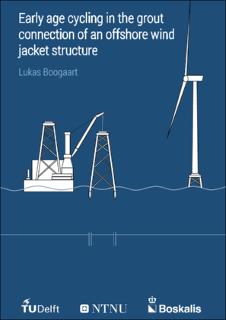| dc.description.abstract | The yearly installed percentage of offshore wind jacket substructures is rising. The most common installation method for a jacket structure nowadays starts by driving the foundation piles in the seabed through a pre-piling template. The jacket is then lowered on top until the legs are resting on the foundation piles through friction-based stopper connections. In order to rigidly fix the connection, grout is pumped into the annulus between the pile and leg. During the curing period of grout, generally taken as 24 hours, environmental loads cause the jacket to oscillate in various directions. As a result, the jacket leg will move relative to the foundation pile. This movement, which is called Early Age Cycling (EAC), can cause crack formation in the cured grout therefore decreasing the shear capacity of the connection. The DNV GL has restricted this relative movement to a conservative 1 mm within the first 24 hours due to a research gap on the subject. The strict regulation forces companies to use expensive EAC mitigation concepts of which the real effects are a debated issue.
The objective of this research is to gain insight into the modelling approach and the magnitude of EAC movements and investigate how they can most efficiently be minimized. This is achieved by investigating three phases: 1) simulating a number of load cases on a global jacket model and extracting interface forces near the seabed, 2) using these interface forces to assess the EAC movement on a detailed pile-leg reference model with a full circular stopper 3) analysing this reference stopper by testing three modified configurations. These configurations are designed with respectively two, three and four brackets yielding the same contact area. A sensitivity study is then performed by increasing the contact area.
The largest EAC movement within all models can be measured at the tip of the jacket leg. The location of this movement on the circumference of the leg varies based on the loading condition and stopper model. In general simulations on the reference model showed EAC movements below 1 mm due to a uniform stress distribution from the stopper to the foundation pile. For larger wave loads, sliding occurred resulting in large EAC movements. The initial modified configurations show significantly larger EAC movement when compared to the reference stopper. In general, the EAC movement decrease when the number of brackets increases. This is the result of a more even stress distribution around the circumference of the pile. A phenomenon visible for the two bracket stopper is rotation around the axis of the wave direction resulting in large EAC movement. This effect, denoted as moment induced rotations, should be limited by all means. A sensitivity analysis on friction showed that sliding could most efficiently be solved by increasing the friction coefficient. This is highly recommended since it greatly improves the performance of the stopper connection for larger waves.
This research could be further extended by performing a large sensitivity study to normalize the current results. This would be needed to verify whether the current conclusions can also be adopted for general use. | |
